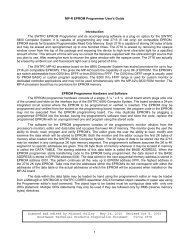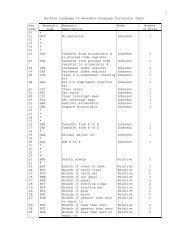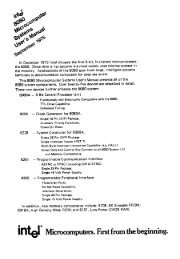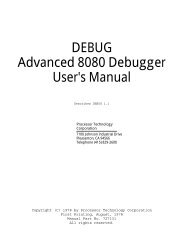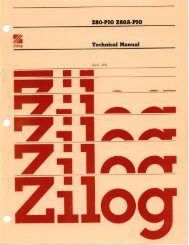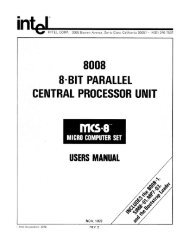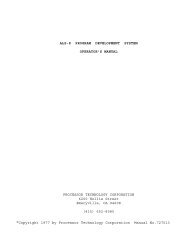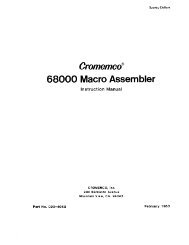The System Manual of SOL-20 - History of Computers
The System Manual of SOL-20 - History of Computers
The System Manual of SOL-20 - History of Computers
Create successful ePaper yourself
Turn your PDF publications into a flip-book with our unique Google optimized e-Paper software.
PROCESSOR TECHNOLOGY CORPORATION<br />
Sol THEORY OF OPERATION<br />
SECTION VIII<br />
U100. <strong>The</strong> output on pin 12 <strong>of</strong> U100 is inverted by U109 and applied<br />
to the receive input (pin <strong>20</strong>) <strong>of</strong> the UART.<br />
<strong>The</strong> Q output on pin 1 <strong>of</strong> U113, which occurs at the actual bit<br />
rate <strong>of</strong> the incoming data, is also used by the receive clock circuitry<br />
to reconstruct the receive clock from the data signal.<br />
Received data undergoes serial-to-parallel conversion in the<br />
UART and is placed on the RO1-8 data outputs <strong>of</strong> the UART when ROD<br />
(pin 4 <strong>of</strong> the UART) is low (!PORT_IN_FB active) and onto INT0-7.<br />
Four status outputs from the UART can also be enabled when<br />
SFD (pin 16) is low. <strong>The</strong>se four bits are FE (framing error), OE<br />
(overrun error), DR (data ready) and TBRE (transmitter buffer register<br />
empty).<br />
8.6 KEYBOARD<br />
8.6.1 Block Diagram Analysis<br />
A simplified block diagram <strong>of</strong> the keyboard is provided on<br />
Page X-25 in Section X.<br />
<strong>The</strong> Clock Oscillator produces the basic timing signals for<br />
the keyboard, and they are distributed as indicated.<br />
At the heart <strong>of</strong> the keyboard is a Key Switch Capacitive<br />
Matrix which can be viewed as a 16 x 16 X-Y matrix, with X being the<br />
column and Y the row. Conceptually, a key depression increases the capacitance<br />
between the X and Y coordinates that uniquely define that<br />
key.<br />
<strong>The</strong> Column Scanner supplies a pulse train to the X lines in<br />
the matrix, with only one line being pulsed at any given point in<br />
time. When a key is depressed to increase the capacitance between the<br />
Column Scanner output and a Row Scanner input, the X-Y coordinates<br />
for that key are detected to provide an input to the Sense Circuit.<br />
<strong>The</strong> Sense Circuit in turn generates an input to the Sequence<br />
Detector when a key closure occurs. This detector basically detects<br />
key closures and count cycles <strong>of</strong> the Row Scanner to discriminate<br />
against false key signals and insure that valid closures are serviced<br />
in order.<br />
In the absence <strong>of</strong> key closures, the Sequence Detector feeds<br />
PKD to the Sense Circuit to increase its threshold. This action<br />
serves to increase the circuit's noise immunity. On valid key closures,<br />
the PKD input is such as to decrease the Sense Circuit's<br />
threshold. When valid key closures exist, the Sequence Detector<br />
strobes data into the Output Latch. <strong>The</strong> low order four bits to this<br />
latch are supplied by the Row Scanner; the high order four bits are<br />
VIII-38



